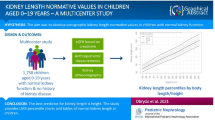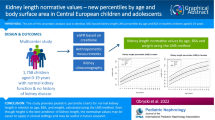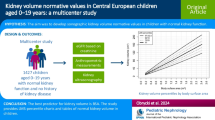Abstract
Objectives
In this population-based study, reference values were generated for renal length, and the heritability and factors associated with kidney length were assessed.
Methods
Anthropometric parameters and renal ultrasound measurements were assessed in randomly selected nuclear families of European ancestry (Switzerland). The adjusted narrow sense heritability of kidney size parameters was estimated by maximum likelihood assuming multivariate normality after power transformation. Gender-specific reference centiles were generated for renal length according to body height in the subset of non-diabetic non-obese participants with normal renal function.
Results
We included 374 men and 419 women (mean ± SD, age 47 ± 18 and 48 ± 17 years, BMI 26.2 ± 4 and 24.5 ± 5 kg/m2, respectively) from 205 families. Renal length was 11.4 ± 0.8 cm in men and 10.7 ± 0.8 cm in women; there was no difference between right and left renal length. Body height, weight and estimated glomerular filtration rate (eGFR) were positively associated with renal length, kidney function negatively, age quadratically, whereas gender and hypertension were not. The adjusted heritability estimates of renal length and volume were 47.3 ± 8.5 % and 45.5 ± 8.8 %, respectively (P < 0.001).
Conclusion
The significant heritability of renal length and volume highlights the familial aggregation of this trait, independently of age and body size. Population-based references for renal length provide a useful guide for clinicians.
Key Points
• Renal length and volume are heritable traits, independent of age and size.
• Based on a European population, gender-specific reference values/percentiles are provided for renal length.
• Renal length correlates positively with body length and weight.
• There was no difference between right and left renal lengths in this study.
• This negates general teaching that the left kidney is larger and longer.

Similar content being viewed by others
References
Soldo D, Brkljacic B, Bozikov V, Drinkovic I, Hauser M (1997) Diabetic nephropathy. Comparison of conventional and duplex Doppler ultrasonographic findings. Acta Radiol 38:296–302
Emamian SA, Nielsen MB, Pedersen JF (1995) Intraobserver and interobserver variations in sonographic measurements of kidney size in adult volunteers. A comparison of linear measurements and volumetric estimates. Acta Radiol 36:399–401
Bakker J, Olree M, Kaatee R et al (1999) Renal volume measurements: accuracy and repeatability of US compared with that of MR imaging. Radiology 211:623–628
Brandt TD, Neiman HL, Dragowski MJ, Bulawa W, Claykamp G (1982) Ultrasound assessment of normal renal dimensions. J Ultrasound Med 1:49–52
Emamian SA, Nielsen MB, Pedersen JF (1994) Tenth percentiles of kidney length in adult volunteers. AJR Am J Roentgenol 163:748
Rivolta R, Cardinale L, Lovaria A, Di Palo FQ (2000) Variability of renal echo-Doppler measurements in healthy adults. J Nephrol 13:110–115
Raza M, Hameed A, Khan MI (2011) Ultrasonographic assessment of renal size and its correlation with body mass index in adults without known renal disease. J Ayub Med Coll Abbottabad 23:64–68
Singh GR, Hoy WE (2004) Kidney volume, blood pressure, and albuminuria: findings in an Australian aboriginal community. Am J Kidney Dis 43:254–259
Emamian SA, Nielsen MB, Pedersen JF, Ytte L (1993) Sonographic evaluation of renal appearance in 665 adult volunteers. Correlation with age and obesity. Acta Radiol 34:482–485
Emamian SA, Nielsen MB, Pedersen JF, Ytte L (1993) Kidney dimensions at sonography: correlation with age, sex, and habitus in 665 adult volunteers. AJR Am J Roentgenol 160:83–86
Raman GV, Clark A, Campbell S, Watkins L, Osmond C (1998) Is blood pressure related to kidney size and shape? Nephrol Dial Transplant 13:728–730
Stergiou GS, Giovas PP, Gkinos CP, Tzamouranis DG (2008) Validation of the A&D UM-101 professional hybrid device for office blood pressure measurement according to the International Protocol. Blood Press Monit 13:37–42
Pruijm MT, Wuerzner G, Glatz N et al (2010) A new technique for simultaneous validation of two manual nonmercury auscultatory sphygmomanometers (A&D UM-101 and Accoson Greenlight 300) based on the International protocol. Blood Press Monit 15:322–325
O’Brien E, Asmar R, Beilin L et al (2003) European Society of Hypertension recommendations for conventional, ambulatory and home blood pressure measurement. J Hypertens 21:821–848
Genuth S, Alberti KG, Bennett P et al (2003) Follow-up report on the diagnosis of diabetes mellitus. Diabetes Care 26:3160–3167
Jones TB, Riddick LR, Harpen MD, Dubuisson RL, Samuels D (1983) Ultrasonographic determination of renal mass and renal volume. J Ultrasound Med 2:151–154
Levey AS, Stevens LA, Schmid CH et al (2009) A new equation to estimate glomerular filtration rate. Ann Intern Med 150:604–612
Keller C, Katz R, Cushman M, Fried LF, Shlipak M (2008) Association of kidney function with inflammatory and procoagulant markers in a diverse cohort: a cross-sectional analysis from the Multi-Ethnic Study of Atherosclerosis (MESA). BMC Nephrol 9:9
Cole TJ, Green PJ (1992) Smoothing reference centile curves: the LMS method and penalized likelihood. Stat Med 11:1305–1319
Rigby RA, Stasinopoulos DM (2004) Smooth centile curves for skew and kurtotic data modelled using the Box-Cox power exponential distribution. Stat Med 23:3053–3076
Bochud M, Elston RC, Maillard M et al (2005) Heritability of renal function in hypertensive families of African descent in the Seychelles (Indian Ocean). Kidney Int 67:61–69
Bochud M, Bovet P, Elston RC et al (2005) High heritability of ambulatory blood pressure in families of East African descent. Hypertension 45:445–450
Hoy WE, Douglas-Denton RN, Hughson MD, Cass A, Johnson K, Bertram JF (2003) A stereological study of glomerular number and volume: preliminary findings in a multiracial study of kidneys at autopsy. Kidney Int Suppl S31–S37
Keijzer-Veen MG, Devos AS, Meradji M, Dekker FW, Nauta J, van der Heijden BJ (2010) Reduced renal length and volume 20 years after very preterm birth. Pediatr Nephrol 25:499–507
Oyuela-Carrasco J, Rodriguez-Castellanos F, Kimura E, Delgado-Hernandez R, Herrera-Felix JP (2009) Renal length measured by ultrasound in adult mexican population. Nefrologia 29:30–34
Glodny B, Unterholzner V, Taferner B et al (2009) Normal kidney size and its influencing factors—a 64-slice MDCT study of 1.040 asymptomatic patients. BMC Urol 9:19
Paivansalo M, Huttunen K, Suramo I (1985) Ultrasonographic findings in renal parenchymal diseases. Scand J Urol Nephrol 19:119–123
Tuma J, Heynemann H (2006) [Ultrasound differential diagnosis in renal parenchymal disease]. Praxis (Bern 1994) 95:721–727
O’Neill WC (2000) Sonographic evaluation of renal failure. Am J Kidney Dis 35:1021–1038
Miletic D, Fuckar Z, Sustic A, Mozetic V, Stimac D, Zauhar G (1998) Sonographic measurement of absolute and relative renal length in adults. J Clin Ultrasound 26:185–189
Cheong B, Muthupillai R, Rubin MF, Flamm SD (2007) Normal values for renal length and volume as measured by magnetic resonance imaging. Clin J Am Soc Nephrol 2:38–45
Michielsen K, Meersschaert J, De Keyzer F, Cannie M, Deprest J, Claus F (2010) MR volumetry of the normal fetal kidney: reference values. Prenat Diagn 30:1044–1048
Acknowledgments
M.P., B.P., D.A., G.E. and I.G. and the study were supported by a grant from the Swiss National Science Foundation (FN 33CM30-124087). Some of the results of this paper were obtained by using the program package S.A.G.E., which was supported by a U.S. Public Health Service Resource Grant (RR03655) from the National Center for Research Resources.
Conflicts of interest
None.
Author information
Authors and Affiliations
Corresponding author
Electronic supplementary material
Below is the link to the electronic supplementary material.
Supplementary Table A
Associations between mean renal volume (in ml) and phenotypic characteristics of all participants (n = 793), assessed by multilevel multivariable linear regression, and expressed as regression coefficient β (95 % CI) (DOCX 18 kb)
Rights and permissions
About this article
Cite this article
Pruijm, M., Ponte, B., Ackermann, D. et al. Heritability, determinants and reference values of renal length: a family-based population study. Eur Radiol 23, 2899–2905 (2013). https://doi.org/10.1007/s00330-013-2900-4
Received:
Revised:
Accepted:
Published:
Issue Date:
DOI: https://doi.org/10.1007/s00330-013-2900-4




